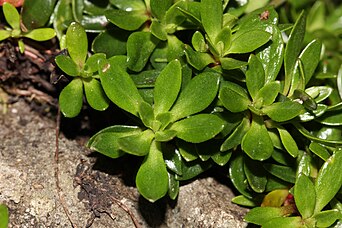Androsace laevigata
| Androsace laevigata | |
|---|---|

| |
| Growing in Olympic National Park, Washington | |
| Scientific classification | |
| Kingdom: | Plantae |
| Clade: | Tracheophytes |
| Clade: | Angiosperms |
| Clade: | Eudicots |
| Clade: | Asterids |
| Order: | Ericales |
| Family: | Primulaceae |
| Genus: | Androsace |
| Species: | A. laevigata
|
| Binomial name | |
| Androsace laevigata (A.Gray) Wendelbo[1]
| |
| Synonyms[1] | |
| |
Androsace laevigata, synonym Douglasia laevigata, known as the cliff dwarf primrose,[2] is a species of flowering plant in the primrose family, Primulaceae. It is native to the central Pacific coastal mountains of North America (west of the crest of the Cascade Range of British Columbia, Oregon and Washington) below 2,400 metres (8,000 ft) elevation. Its habitat includes cliffs, rocks, and alpine.[1][3][4][5]
Description
[edit]Androsace laevigata is a small mat-forming herbaceous perennial plant about 2–7 cm (0.8–2.8 in) high. The five-lobed flowers are deep pink to rose. Each lobe is 4–5 mm (0.2–0.2 in) mm long.[4][5]
Taxonomy
[edit]Androsace laevigata was first described by Asa Gray in 1880 as Douglasia laevigata.[6] Molecular phylogenetic studies showed that the genus Douglasia is nested within Androsace,[7][8] and the transfer to Androsace by Wendelbo in 1961[9] is now accepted.[1]
-
Flowers
-
Leaves
References
[edit]- ^ a b c d "Androsace laevigata (A.Gray) Wendelbo", Plants of the World Online, Royal Botanic Gardens, Kew, retrieved 2020-07-05
- ^ Kelso, Sylvia, "Douglasia laevigata", in Flora of North America Editorial Committee (ed.), Flora of North America (online), eFloras.org, retrieved 2020-07-05
- ^ Sullivan, Steven. K. (2020). "Douglasia laevigata". Wildflower Search. Retrieved 2020-09-22.
- ^ a b Klinkenberg, Brian, ed. (2020). "Douglasia laevigata". E-Flora BC: Electronic Atlas of the Plants of British Columbia [eflora.bc.ca]. Lab for Advanced Spatial Analysis, Department of Geography, University of British Columbia, Vancouver. Retrieved 2020-09-22.
- ^ a b Giblin, David, ed. (2020). "Douglasia laevigata". WTU Herbarium Image Collection. Burke Museum, University of Washington. Retrieved 2020-09-22.
- ^ "Douglasia laevigata A.Gray", International Plant Names Index (IPNI), Royal Botanic Gardens, Kew; Harvard University Herbaria & Libraries; Australian National Botanic Gardens, retrieved 2019-05-09
- ^ Trift, I.; Anderberg, A.A. & Källersjö, M. (2002), "The monophyly of Primula (Primulaceae) evaluated by analysis of sequences from the chloroplast gene rbcL.", Systematic Botany, 27 (2): 396–407, JSTOR 3093879
- ^ Schneeweiss, Gerald M.; Schönswetter, Peter; Kelso, Sylvia & Niklfeld, Harald (2004), "Complex biogeographic patterns in Androsace (Primulaceae) and related genera: evidence from phylogenetic analyses of nuclear internal transcribed spacer and plastid trnL-F sequences", Systematic Biology, 53 (6): 856–876, doi:10.1080/10635150490522566, JSTOR 4135374, PMID 15764556
- ^ "Androsace laevigata (A.Gray) Wendelbo", International Plant Names Index (IPNI), Royal Botanic Gardens, Kew; Harvard University Herbaria & Libraries; Australian National Botanic Gardens, retrieved 2019-05-09
External links
[edit] Media related to Androsace laevigata at Wikimedia Commons
Media related to Androsace laevigata at Wikimedia Commons


